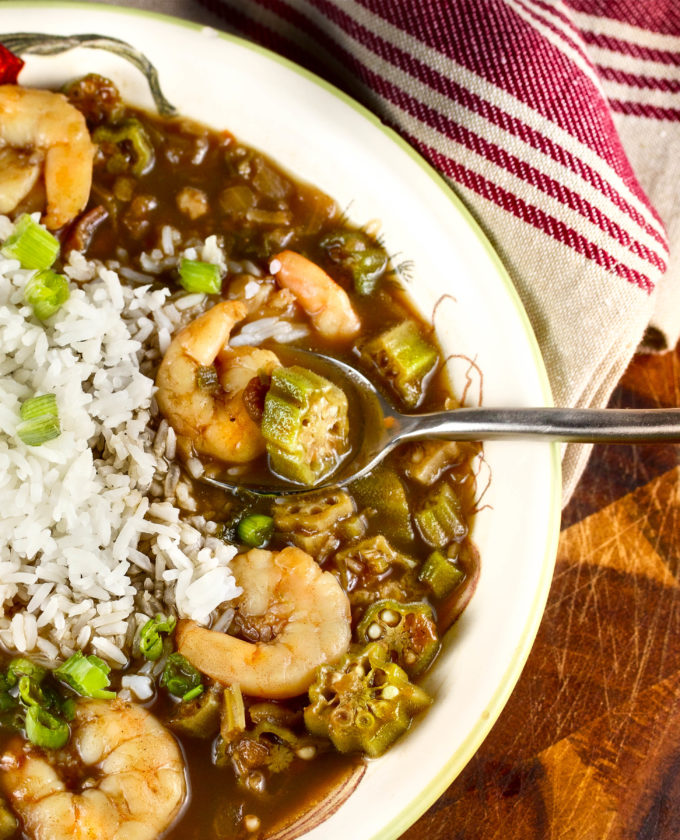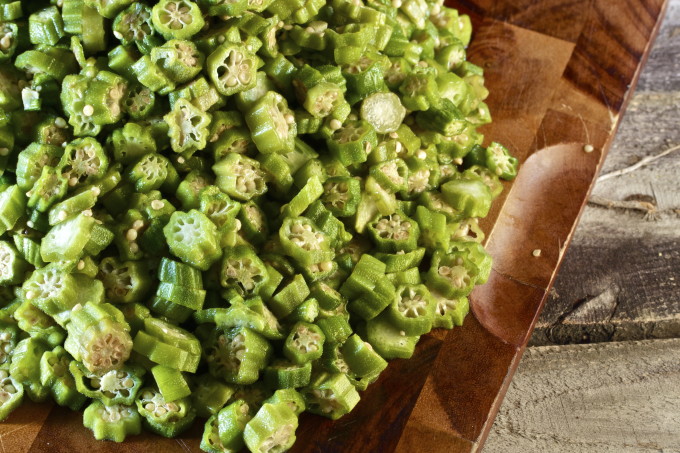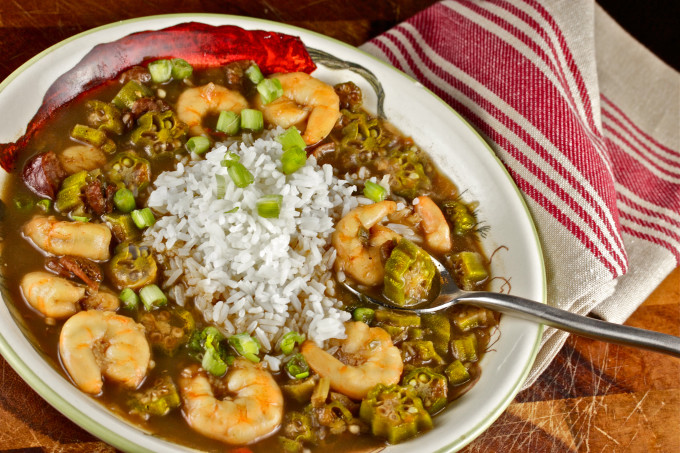Last week I told a good friend that I intended to make shrimp and Okra Gumbo for the weekend. Without hesitation, he asked: “Cajun Gumbo or Creole Gumbo?” Oh here I am going again. After a 10 -minute explanation, I could see that my friend regrets even asked the question. But, it is a difficult subject and one that has hired the highest level of scientist study. If you have a timid a bit of ten minutes, pour another cup of coffee and hear it out.

Shrimp and Okra Gumbo combine all the best of the cooking and cooking in a delicious bowl. (All Credit Photos: George Graham)
So what is the difference between Cajun cooking and Creole cooking? For a food writer in Louisiana who covers Cajun and the Creole cooking, this is similar to the question: “What is in a gumbo?” There is no clear answer and this is the beauty of culture and kitchen. With the risk of worsening me in culinary controversies, let me shed light on this long and sometimes lit debate.
The difference between the two is most easily explained by the look of the two cultures and their geography. The Europeans of wealth and stature settled in the city of New Orleans and brought with them a palace for a milder kitchen reminiscent of their French, Spanish or English roots. Over time, servants and chefs of African origin have learned these sophisticated recipes and techniques and mixed them with their spicy cooking, infused with herbs. For a long time, the tastes were mixed in a soul mixture that became the defining taste of the creole. Cooking with tomatoes, cream, butter, cheese and other more refined ingredients led to the rich kitchen for which New Orleans became famous. The French sauce techniques have helped to define foods such as shrimp remulars, Meunière trout, Osre Bienville, Ravigote crab and many other great creole dishes. And those classic European dishes were joined by homemade creole foods, such as Gumbo Z’herbes, smoked red beans and rice, OKRA dishes, as well as an infused tomato version of Jambalaya.
Meanwhile, in the Southern swamps -Louisiana Vest has taken place another kind of culinary evolution. In 1755, the expulsion of the French acadians in Nova Scotia by the British led to the migration of thousands of families to the wet areas of southern Louisiana. Throughout the bay coast and north, in the Prairie region of Acadian, the colonists put roots. They were not rich people, but mere agricultural families. In order to survive, they caught, fished and hunted for food and applied the basic French rural culinary skills on simple cajun recipes that fit their palace. The colonists throughout the coastal parishes and have lived through shrimp, crabbing and harvesting; Further inwards, the cultivation of payment land with sugar and rice as predominant crops has led to Cajun recipes using all these indigenous ingredients. The Atchafalaya basin was a wild source for crawfish and, finally, the rice fields were flooded after the cold agriculture harvest in a controlled aquaculture environment. Over time, the Germans settled in the northern region of Lafayette and brought with them sausage and smoke skills, which have been beautifully mixed in gumbo aromas that we know now as Cajun.

Shrimp and Okra Gumbo is a recipe that connects the Louisiana crops.
The family plays an important role in Caun’s food. Even today, the holidays burst whenever families meet to cook a whole pig. Boucherie and lait shell are French traditions that are important for the Cajun lifestyle. Even the colds of colds are family holidays that bring together people over food. Food is a key ingredient of Joie of Vivre to live in southern Louisiana.
I heard the Cajun food described as a basic and unfinished method of rustic, rural, farm. I disagree. For me, this description reduces the talent and taste of the culinary art of the French acadians. I think the evolution of this distinctly original kitchen is based on handmade techniques taught by generations and preserved as a cultural treasure. Pride and passion for cooking Cajun are just as defining elements of people, such as music, dance and tongue. Deep Gumbos, dark, spicy tasso, Rich crawfish étouffée and rice of black iron and rice are original recipes, rooted in historical reverence for a resistant culture.
But the explanation does not end there.
I argue that, over time, Cajun and Creole kitchens have converged in a unique, intercultural kitchen, which is represented throughout Louisiana. The Holy Trinity of the spices – Onion, Bell Pepur and Celery – is the divine starting point of both kitchens. Okra often appears in Gumbos on both sides of the Atchafalaya basin, and a bowl of creamy red beans with smoked Andouille is a connection that puts the two cultures deliciously. The beauty of food in Louisiana is to mix the flavors in unexpected and surprisingly unique dishes.
Let the debate end. What is the real kitchen in Louisiana? Who cares? The fading of the lines of distinguishing these two cultures led to a truly original, unique kitchen. To celebrate and illustrate this union, I offer a hot bowl of shrimp and Gumbo Okra.
A bite and you will understand clearly.

The freshly cut Okra adds a brain touch to this recipe for shrimp and gumbo okra.
Shrimp and gumbo okra
Recipe of: George Graham – AcadianaTable.com
Serves: 6 to 8
ingredients
- ¼ cup canola oil
- 2 cups of cut yellow onion
- 2 cups with pepper cuts with cut
- 2 cups of chopped celery
- 2 tablespoons garlic chopped
- ½ cup of parsley with chopped flat leaves
- 1 cup chopped tasso or smoked ham
- 2 tablespoons of tomatoes
- 12 cups of stock of shrimp or stock of seafood, plus water, if needed
- 1 cup of dry shrimp
- 2 sliced cups okra
- 1 ½ cups Dark Roux such as Rox’s Roux
- 1 tablespoon of Cayenne hot pepper
- Kosher salt and freshly ground black pepper
- 3 fresh pounds of big shrimp from Louisiana
- Hot sauce
- 8 cups has cooked white rice in Louisiana, for serving, like supreme
- 1 cup of green onion tops cut with cut
- Filé powder
Instructions
- In a large cast iron bowl over medium heat, add ¼ cup of canola oil. Once it was thrown hot, add the onion, bell peppers and celery. You jump until the onion turns translucent. Add the garlic, parsley and tasso and leave it to the combination. Add the tomato paste and mix to combine.
- Add shrimp stock together with dry shrimp. Add the sliced okra. Bring to a boil and add Roux. Get down the heat to a low heat and season with the Cayenne pepper. Cover the pot and let cook for 1 hour.
- After 1 hour, lift the lid and tasting the surface of any excess oil. Gumbo tastes. If you prefer thinner gumbo, add more stock or water. Add salt and pepper to taste. Add the shrimp, cover the pot and boil for more than 20 minutes. Turn off the heat.
- Discover the pot and taste the surface of any excess oil. Project the finished gumbo and season with hot sauce to taste.
- Remove GUMBO in large bowls over a rice mound and garnish with cut onion countertops. You have filé powder and hot sauce on the table for adding. Serve with hot French bread.
Notes
3.5.3217

The mixing of a deep dark Roux caun with Okra Creole is the basis for introducing fresh golf shrimp in this shrimp and Okra Gumbo – a classic dish in southern Louisiana.
Your chair at the table: If you like this Cajun cooking story and Cajun recipe then aCCECT My personal invitation to subscribe by introducing your e -mail at the bottom or right right of this page. It is fast and painless. You will receive an Email alert and you will be the first to see when you add new cookies and cajun recipes.
Thank you, George.